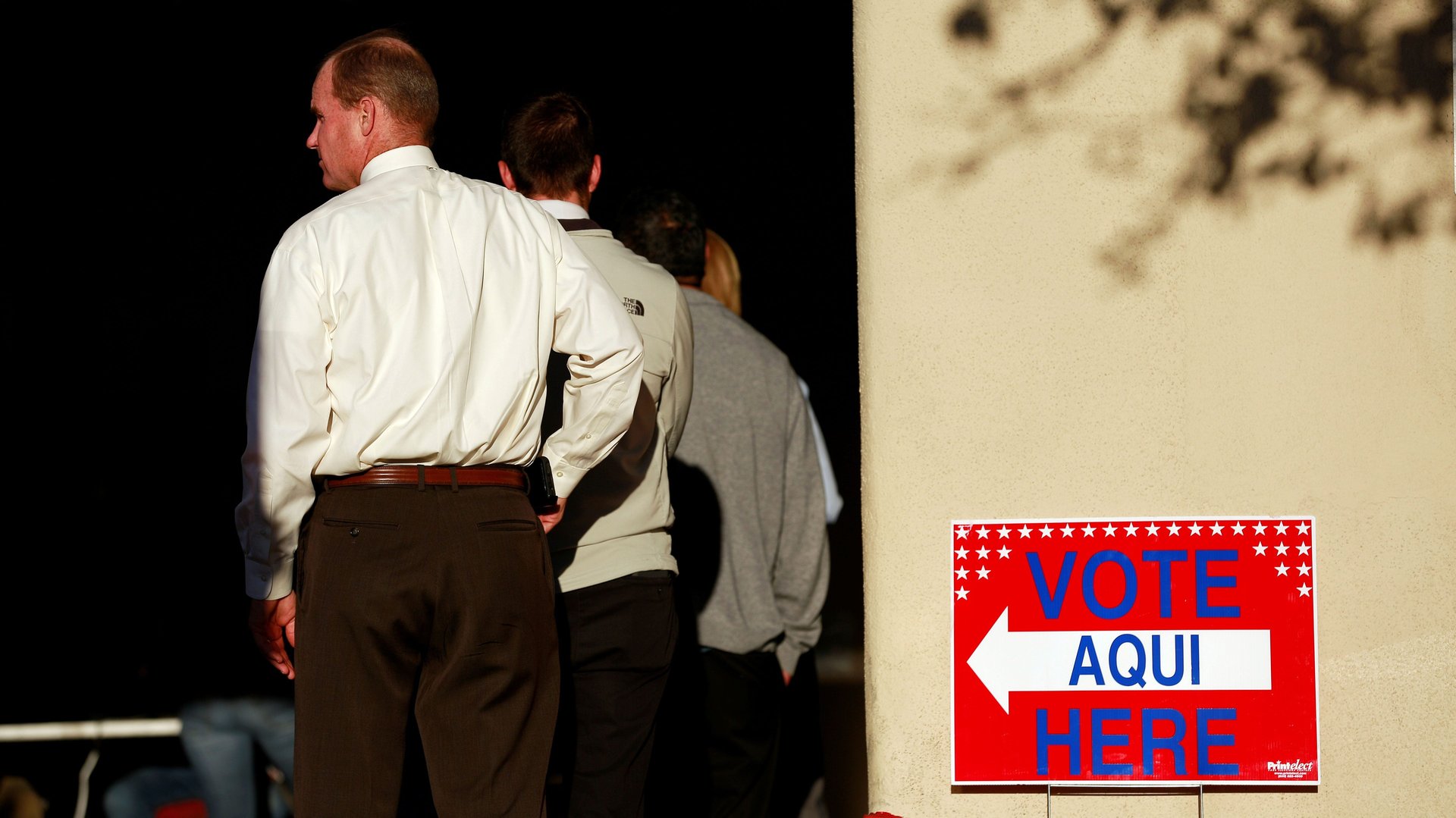Broken machines and user error are leading to hour-long lines at polling booths
Texas resident Brianna Smith, who lives in Katy, a Houston suburb, turned up 15 minutes before the polls opened at 7 am to vote this morning (Nov. 6). She wasn’t able to do so for nearly two hours, because of problems with the machine that gives voters their tickets. The lines were “wrapped around the block,” she told Quartz, with some voters forced to leave to go to work or school.


Texas resident Brianna Smith, who lives in Katy, a Houston suburb, turned up 15 minutes before the polls opened at 7 am to vote this morning (Nov. 6). She wasn’t able to do so for nearly two hours, because of problems with the machine that gives voters their tickets. The lines were “wrapped around the block,” she told Quartz, with some voters forced to leave to go to work or school.
Across the country, ballot scanners on the blink and broken voting machines are contributing to massive lines. Experts say that these errors are normal, but the long waits might ultimately prevent some from casting their votes.
Tech glitches at the polls
The problems are being reported across the country, with many tips sent through to the ElectionLand project and verified by Quartz and other news outlets. In New York City, high voter turn-out combined with broken scanners caused mayhem throughout the city at dozens of polling places. At one station in Flatbush, Brooklyn, two of the four voting machines were broken, resulting in a backlog of well over 100 people. A mechanic was later dispatched to repair them, according to a Quartz reporter there.
Voters who showed up at the Bronx County Supreme Court House in the morning were issued paper ballots after all scanning machines stopped working. Site coordinator Eladio Perez told reporters he guaranteed the machines would be fixed and all votes scanned later.
Similar issues with overheating or malfunctioning scanners were reported in Greenpoint and Prospect Heights, also in Brooklyn; Forest Hills, Queens; and other polling spots around the city. The city’s Board of Elections told Quartz they would look into the problem.
In some cases, the reported malfunctions were due to user error. In Indianapolis, the one volunteer at West Lake Elementary School forgot to plug in the optical scanners after being confronted with a flood of prospective voters, ProPublica reports. Instead, voters were asked to cast their ballots on paper and post them into a secure box, to be scanned later when the systems were running.
At a polling station in Aleif, another Houston suburb, poll workers had to input addresses manually to stop the line from being held up after their iPads went down. The election judge at the location told the Houston Chronicle that the machines had stopped working “for less than ten minutes”—though by 8 am, an hour after polls opened, the line was around 70 people-long.
The back-up plan for a broken machine
Technology glitches are a relatively routine occurrence during elections, and many polling places have backup plans. For example, if voters are using hand-marked paper ballots and the scanner at the polling place doesn’t work, they can cast their ballot into an emergency ballot box to be stored and scanned later. Under federal law, all polling places are required to have backup paper ballots—for voters whose eligibility has already been established—or provisional ballots (for those whose eligibility needs to be confirmed) for federal races.
But the National Conference of State Legislatures notes that Idaho, Minnesota, New Hampshire, North Dakota, Wisconsin, and Wyoming are exempt from the federal mandate to provide provisional ballots. And local races are regulated according to state laws, so not all of them have replacement ballots. If machines don’t work in those places, voters might simply have to return later—if they can.
Voters waiting outside the polls in Texas and New York Tuesday morning reported that they watched others abandon the queue after long waits.
It’s unclear what kind of impact delays caused by broken machines have on actual turnout, says Charles Stewart, director at MIT’s Election Lab, which collects and analyzes election data. “It looks like 1% of voters abandon a line on Election Day, but how many return later, no one knows,” he adds.
Any delays or inconveniences at the polls are problematic because of their potential to dissuade citizens from voting. “It’s never a minor problem if you are the voter stuck in a longer line because of a machine problem, or the poll worker trying to deal with it,” says Trey Greyson, the former director of the Harvard Institute of Politics. “That being said, at this point, it seems to be a fairly normal level of machine problems. But we are looking at anecdotes.”
Daniel Whateley contributed reporting.
This story started as a tip from ProPublica’s Electionland project, which monitors voting problems around the country. If you had trouble voting, or if you saw something you want to tell us about, here’s how.